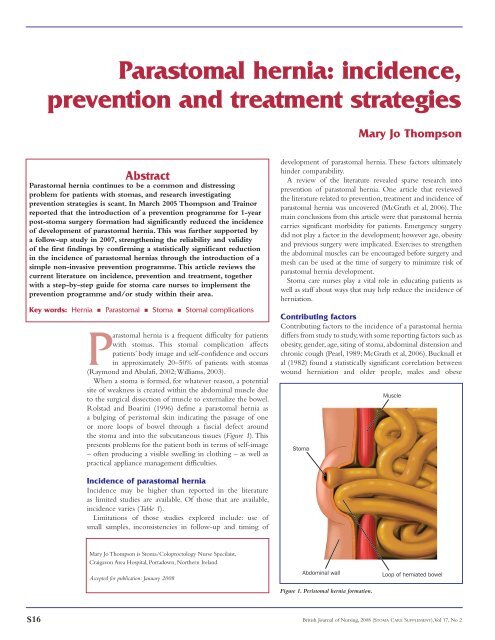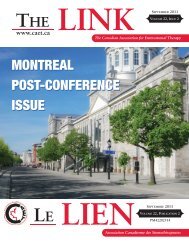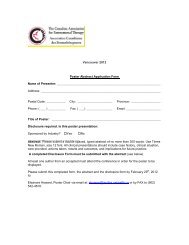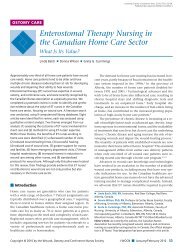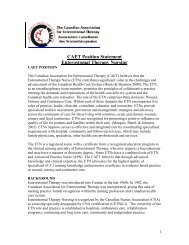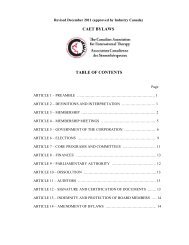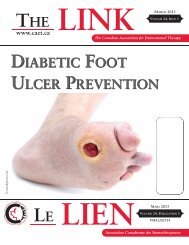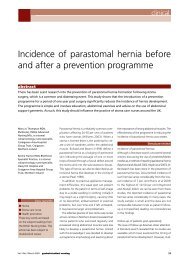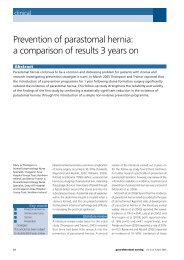Parastomal hernia: incidence, prevention and treatment strategies
Parastomal hernia: incidence, prevention and treatment strategies
Parastomal hernia: incidence, prevention and treatment strategies
You also want an ePaper? Increase the reach of your titles
YUMPU automatically turns print PDFs into web optimized ePapers that Google loves.
<strong>Parastomal</strong> <strong>hernia</strong>: <strong>incidence</strong>,<br />
<strong>prevention</strong> <strong>and</strong> <strong>treatment</strong> <strong>strategies</strong><br />
Abstract<br />
<strong>Parastomal</strong> <strong>hernia</strong> continues to be a common <strong>and</strong> distressing<br />
problem for patients with stomas, <strong>and</strong> research investigating<br />
<strong>prevention</strong> <strong>strategies</strong> is scant. In March 2005 Thompson <strong>and</strong> Trainor<br />
reported that the introduction of a <strong>prevention</strong> programme for 1-year<br />
post-stoma surgery formation had significantly reduced the <strong>incidence</strong><br />
of development of parastomal <strong>hernia</strong>. This was further supported by<br />
a follow-up study in 2007, strengthening the reliability <strong>and</strong> validity<br />
of the first findings by confirming a statistically significant reduction<br />
in the <strong>incidence</strong> of parastomal <strong>hernia</strong>s through the introduction of a<br />
simple non-invasive <strong>prevention</strong> programme. This article reviews the<br />
current literature on <strong>incidence</strong>, <strong>prevention</strong> <strong>and</strong> <strong>treatment</strong>, together<br />
with a step-by-step guide for stoma care nurses to implement the<br />
<strong>prevention</strong> programme <strong>and</strong>/or study within their area.<br />
Key words: Hernia n <strong>Parastomal</strong> n Stoma n Stomal complications<br />
<strong>Parastomal</strong> <strong>hernia</strong> is a frequent difficulty for patients<br />
with stomas. This stomal complication affects<br />
patients’ body image <strong>and</strong> self-confidence <strong>and</strong> occurs<br />
in approximately 20–50% of patients with stomas<br />
(Raymond <strong>and</strong> Abulafi, 2002; Williams, 2003).<br />
When a stoma is formed, for whatever reason, a potential<br />
site of weakness is created within the abdominal muscle due<br />
to the surgical dissection of muscle to externalize the bowel.<br />
Rolstad <strong>and</strong> Boarini (1996) define a parastomal <strong>hernia</strong> as<br />
a bulging of peristomal skin indicating the passage of one<br />
or more loops of bowel through a fascial defect around<br />
the stoma <strong>and</strong> into the subcutaneous tissues (Figure 1). This<br />
presents problems for the patient both in terms of self-image<br />
– often producing a visible swelling in clothing – as well as<br />
practical appliance management difficulties.<br />
Incidence of parastomal <strong>hernia</strong><br />
Incidence may be higher than reported in the literature<br />
as limited studies are available. Of those that are available,<br />
<strong>incidence</strong> varies (Table 1).<br />
Limitations of those studies explored include: use of<br />
small samples, inconsistencies in follow-up <strong>and</strong> timing of<br />
Mary Jo Thompson is Stoma/Coloproctology Nurse Specilaist,<br />
Craigavon Area Hospital, Portadown, Northern Irel<strong>and</strong><br />
Accepted for publication: January 2008<br />
Mary Jo Thompson<br />
development of parastomal <strong>hernia</strong>. These factors ultimately<br />
hinder comparability.<br />
A review of the literature revealed sparse research into<br />
<strong>prevention</strong> of parastomal <strong>hernia</strong>. One article that reviewed<br />
the literature related to <strong>prevention</strong>, <strong>treatment</strong> <strong>and</strong> <strong>incidence</strong> of<br />
parastomal <strong>hernia</strong> was uncovered (McGrath et al, 2006). The<br />
main conclusions from this article were that parastomal <strong>hernia</strong><br />
carries significant morbidity for patients. Emergency surgery<br />
did not play a factor in the development; however age, obesity<br />
<strong>and</strong> previous surgery were implicated. Exercises to strengthen<br />
the abdominal muscles can be encouraged before surgery <strong>and</strong><br />
mesh can be used at the time of surgery to minimize risk of<br />
parastomal <strong>hernia</strong> development.<br />
Stoma care nurses play a vital role in educating patients as<br />
well as staff about ways that may help reduce the <strong>incidence</strong> of<br />
<strong>hernia</strong>tion.<br />
Contributing factors<br />
Contributing factors to the <strong>incidence</strong> of a parastomal <strong>hernia</strong><br />
differs from study to study, with some reporting factors such as<br />
obesity, gender, age, siting of stoma, abdominal distension <strong>and</strong><br />
chronic cough (Pearl, 1989; McGrath et al, 2006). Bucknall et<br />
al (1982) found a statistically significant correlation between<br />
wound <strong>hernia</strong>tion <strong>and</strong> older people, males <strong>and</strong> obese<br />
S16 British Journal of Nursing, 2008 (STOMA CARE SUPPLEMENT), Vol 17, No 2<br />
Stoma<br />
Muscle<br />
Abdominal wall Loop of <strong>hernia</strong>ted bowel<br />
Figure 1. Peristomal <strong>hernia</strong> formation.
Rectus abdominis<br />
muscle<br />
Figure 2. Musculature of the abdomen.<br />
Table 1. Reported <strong>incidence</strong> of parastomal<br />
<strong>hernia</strong> development<br />
Incidence of<br />
parastomal <strong>hernia</strong> Studies<br />
7% Harris et al (2003)<br />
16% Lala et al (2002), Arumugam et al (2003)<br />
20% Pringle <strong>and</strong> Swan (2001)<br />
28% Thompson <strong>and</strong> Trainor (2005)<br />
10–50% Raymond <strong>and</strong> Abulafi (2002)<br />
patients undergoing bowel surgery. Bucknall <strong>and</strong> Ellis (1984)<br />
supported this finding by reporting that chest infection,<br />
wound sepsis, male <strong>and</strong> aged 60+ were contributing factors.<br />
The correlation with age can be explained by the fact that<br />
with increasing age the rectus abdominus muscle becomes<br />
thinner <strong>and</strong> weaker <strong>and</strong> is thus hindered in providing<br />
adequate support for a stoma (Williams, 2003). Thompson<br />
<strong>and</strong> Trainor (2005, 2007) found statistically significant<br />
differences with age in both studies, reinforcing the findings<br />
of Bucknall et al (1982) <strong>and</strong> Bucknall <strong>and</strong> Ellis (1984).<br />
Carne et al (2003) found that no technical factors relating<br />
to the construction of the stoma were shown to prevent stoma<br />
<strong>hernia</strong>tion, e.g. site of stoma formation, trephine size, fascial<br />
fixation <strong>and</strong> closure of lateral space. Thompson <strong>and</strong> Trainor<br />
(2005, 2007) also found no difference in <strong>incidence</strong> of parastomal<br />
<strong>hernia</strong> development when stomas were sited preoperatively.<br />
Yet, an earlier study by Sjodahl et al (1988) found that stomas<br />
constructed through the rectus abdominus muscle had a<br />
statistically significantly lower <strong>incidence</strong> than those constructed<br />
lateral to the rectus abdominus muscle, with <strong>incidence</strong>s of 2.9%<br />
Internal oblique<br />
muscle<br />
Transversus abdominis<br />
muscle<br />
<strong>and</strong> 21.6% respectively (Figure 2). A limitation to this study is<br />
the omission of length of time lapsed from surgery to followup.<br />
Martin <strong>and</strong> Foster (1996) would support this finding as<br />
they found that making an oversized opening for the stoma<br />
in the muscle <strong>and</strong> fascia at time of surgery as a possible cause<br />
of parastomal <strong>hernia</strong> (Kane et al, 2004). It is also important to<br />
point out that most stomas in recent years, whether constructed<br />
with or without siting, would in the majority, if not all cases, be<br />
constructed through the rectus abdominus muscle as this is now<br />
taken as common practice.<br />
Prevention<br />
Thompson <strong>and</strong> Trainor (2005, 2007) investigated the use of<br />
a parastomal <strong>hernia</strong> <strong>prevention</strong> programme that used three<br />
components:<br />
■<br />
■<br />
■<br />
Awareness of potential for development of parastomal<br />
<strong>hernia</strong><br />
Abdominal exercises to strengthen the abdominal muscles<br />
Using abdominal support belts while undertaking heavy<br />
lifting <strong>and</strong> heavy work for 1 year postoperatively.<br />
The findings demonstrated a statistically significant reduction<br />
in <strong>incidence</strong> of parastomal <strong>hernia</strong>s following the introduction of<br />
a <strong>prevention</strong> programme. In year 1, 87 patients were recruited<br />
before the introduction of the programme, of which 28% of<br />
patients developed a parastomal <strong>hernia</strong>. In year 2 a further 114<br />
patients were recruited, of which 14% developed parastomal<br />
<strong>hernia</strong>s, <strong>and</strong> they had received education about the <strong>prevention</strong><br />
programme. In year 3 a further 99 patients were recruited into<br />
the <strong>prevention</strong> programme <strong>and</strong> 17% developed parastomal<br />
<strong>hernia</strong>s, however 7% of this group admitted to non-compliance<br />
with the programme.<br />
These exercises were previously used by physiotherapists while<br />
teaching patients after major abdominal <strong>and</strong> gynaecological<br />
surgery, <strong>and</strong> can be recommended postoperatively or when<br />
the abdominal wound has healed, for all patients who have<br />
undergone stoma-forming surgery. In the study the exercises<br />
were taught from 3 months onwards (10 of each exercise daily<br />
for 1 year postoperatively). Compliance was inquired about at<br />
each review with the patients <strong>and</strong> documented in the nursing<br />
kardex. The findings suggested that the siting of stomas, type of<br />
surgery (emergency or elective) did not have any significance<br />
in the development of parastomal <strong>hernia</strong>.<br />
Overall <strong>incidence</strong> of parastomal <strong>hernia</strong> in year 1 was 28%<br />
(24/87) which is similar to the reported <strong>incidence</strong> within<br />
the literature. In year 2, following the introduction of the<br />
programme, the <strong>incidence</strong> had dropped to 14% (16/114).<br />
Chi-squared – a test for independence evaluating statistically<br />
significant differences between proportions for two or more<br />
groups in a data set – demonstrated significance (P≤0.025),<br />
suggesting that the introduction of the programme had a<br />
statistically significant effect in reducing the <strong>incidence</strong> of<br />
development of parastomal <strong>hernia</strong>s.<br />
When year 1 <strong>and</strong> year 3 were tested Chi-squared did not<br />
demonstrate statistical significance, which suggested unreliability<br />
of the results from the first study. However, on closer examination,<br />
in year 3 compliance had been inquired after from patients at<br />
each review appointment <strong>and</strong> seven of these patients reported<br />
they had not complied with the <strong>prevention</strong> programme. When<br />
these revised figures for those following the programme (10<br />
S18 British Journal of Nursing, 2008 (STOMA CARE SUPPLEMENT), Vol 17, No 2
patients) were analysed using Chi-squared, statistical significance<br />
was found (P≤0.01). This finding thus reinforces the use of this<br />
programme in the <strong>prevention</strong> of parastomal <strong>hernia</strong>, <strong>and</strong> would<br />
demonstrate reliability of the programme.<br />
From these studies, general advice has been compiled for<br />
this article, which can assist stoma care nurses to help their<br />
patients to minimize the risk of development of parastomal<br />
<strong>hernia</strong> (see Table 2 <strong>and</strong> Figure 3). If stoma care nurses wishes<br />
to undertake the study within their area of work, guidance for<br />
this is given in Table 3.<br />
Treatment<br />
Treatments for parastomal <strong>hernia</strong> can be conservative or<br />
surgical. When undertaking conservative <strong>treatment</strong>, reassurance<br />
for the patient (Blackley, 1998; Kane et al, 2004) is fundamental,<br />
as it can be frightening <strong>and</strong> distressing. Correctly fitting<br />
flexible appliances, such as those from ConvaTec, Coloplast,<br />
Dansac, Salts Healthcare, Well<strong>and</strong> Medical <strong>and</strong> Hollister, etc<br />
(Armstrong, 2001; Kane et al, 2004), allows them to mould<br />
to the peristomal skin, ensuring a secure <strong>and</strong> comfortable fit.<br />
Abdominal support belts or girdles, e.g girdles <strong>and</strong> support<br />
belts by Respond Plus Ltd (County Antrim), Ostomy Support<br />
Belts by Salts Healthcare (Birmingham) <strong>and</strong> Corsinel Support<br />
Wear by Coloplast (Peterborough), can be recommended<br />
to provide comfort <strong>and</strong> support for the patient <strong>and</strong> caution<br />
should be stressed to the patient in relation to heavy lifting<br />
<strong>and</strong> heavy work (Kane et al, 2004; McCahon, 1999) to prevent<br />
or minimize further enlargement of the parastomal <strong>hernia</strong>.<br />
Abdominal supports should not have a hole cut in them so<br />
that support is evenly distributed over the whole abdomen.<br />
Patients should be encouraged to exercise their abdominal<br />
muscles to strengthen them; however, surgical permission<br />
should be sought before this if a <strong>hernia</strong> is already present. A<br />
body mass index range of 20–25 should be aimed for <strong>and</strong><br />
regular exercise encouraged.<br />
Surgical repair of parastomal <strong>hernia</strong> can be carried out locally<br />
but this has a high recurrence rate (Everingham, 1998; Baig<br />
et al, 2003). Relocation of the stoma, with or without using<br />
a synthetic mesh (Raymond <strong>and</strong> Abulafi, 2002), is another<br />
option <strong>and</strong> has a more favourable outcome. Several new repair<br />
methods have been investigated; Raymond <strong>and</strong> Abulafi (2002)<br />
used a split mesh technique on three patients <strong>and</strong> all remained<br />
recurrence-free between 18 <strong>and</strong> 24 months.<br />
The repair of parastomal <strong>hernia</strong> is frequently found to be<br />
unsuccessful <strong>and</strong> often has complications. Stoma relocation<br />
is a method of choice for a first parastomal <strong>hernia</strong>. For<br />
recurrence, repair using prosthetic material appears to have<br />
the best outcomes (Rubin, 2004).<br />
Conclusion<br />
<strong>Parastomal</strong> <strong>hernia</strong> presents significant morbidity for patients<br />
having undergone stoma-forming surgery <strong>and</strong> should be<br />
highlighted at preoperative consultations where <strong>and</strong> when<br />
possible, as its <strong>incidence</strong> presents significant risk for patients.<br />
Further research into <strong>prevention</strong> of parastomal <strong>hernia</strong> needs<br />
to be undertaken along with replication of the studies which<br />
have tried new methods of repairing parastomal <strong>hernia</strong>.<br />
It is important to remember that surgical technique plays<br />
an important factor <strong>and</strong> will differ from centre to centre;<br />
Table 2. General advice to help minimize the risk<br />
of parastomal <strong>hernia</strong> development following surgery<br />
Strong abdominal muscles are the premise for this <strong>prevention</strong> programme <strong>and</strong><br />
any general exercise which uses these muscles is beneficial (e.g. swimming,<br />
walking <strong>and</strong> cycling). Please check with your surgeon or stoma care nurse before<br />
undertaking any exercise programme.<br />
1. Avoid heavy lifting for 3 months post-surgery<br />
2. Try to maintain good posture at all times<br />
3. Carry out the exercises below from as early as discharge if the wound has<br />
completely healed<br />
4. Use a support belt or girdle when undertaking heavy lifting or heavy working<br />
after 3 months <strong>and</strong> until at least 12 months postoperatively<br />
5. Keep your weight within the body mass index 20–25<br />
6. Support your stoma <strong>and</strong> abdomen whilst coughing in the first few months<br />
following surgery.<br />
Adapted from: Thompson <strong>and</strong> Trainor (2007)<br />
Pelvic tilting<br />
1. Lie on your back on a<br />
firm surface with knees<br />
bent <strong>and</strong> feet flat on<br />
the bed<br />
2. Pull your tummy in, tilt<br />
your bottom upwards<br />
slightly while pressing<br />
the middle of your<br />
back into the bed <strong>and</strong><br />
hold for two seconds<br />
3. Let go slowly<br />
4. Repeat ten times daily<br />
Knee rolling<br />
1. Lie on your back on a<br />
firm surface with knees<br />
bent <strong>and</strong> feet flat on<br />
the bed<br />
2. Pull your tummy in<br />
<strong>and</strong>, keeping your<br />
knees together, slowly<br />
roll them from side to<br />
side<br />
3. Repeat ten times<br />
Abdominal sit ups<br />
1. Lie on your back on a<br />
firm surface with knees<br />
bent <strong>and</strong> feet flat on<br />
the bed<br />
2. Place your h<strong>and</strong>s on<br />
the front of your thighs<br />
<strong>and</strong> pull your tummy in<br />
3. Lift your head off the<br />
pillow<br />
4. Hold for three seconds,<br />
then slowly return to<br />
starting position<br />
5. Repeat ten times daily<br />
STOMA CARE<br />
Figure 3. Abdominal exercises following stoma-forming surgery (Thompson <strong>and</strong> Trainor, 2007).<br />
British Journal of Nursing, 2008 (STOMA CARE SUPPLEMENT), Vol 17, No 2 S19
Table 3. How to undertake a <strong>prevention</strong> programme study<br />
The study focuses on <strong>prevention</strong> <strong>strategies</strong> for parastomal <strong>hernia</strong> <strong>and</strong> recommends patients undertake a <strong>prevention</strong> programme<br />
based on the premise of strong abdominal muscles reducing the risk of development. This involves advising about <strong>prevention</strong> of<br />
parastomal <strong>hernia</strong>, teaching abdominal exercises to be carried out for 1 year <strong>and</strong> advising the wearing of support garments for<br />
heavy work or heavy lifting in the first year after surgery. It is a combination of these <strong>treatment</strong> modalities that reduces <strong>incidence</strong><br />
of parastomal <strong>hernia</strong> formation.<br />
Steps to take to organize the study:<br />
1. Seek ethical apprpoval (if required) from your Trust<br />
2. A retrospective study of patients operated on in your hospital over a 1-year period who need to have had their surgery at least<br />
1 year ago or else you need to monitor them for 1 year. This is to look at the <strong>incidence</strong> of parastomal <strong>hernia</strong> development prior<br />
to the programme. Assessment can be carried out via computed topography, ultrasound or abdominal assessment.<br />
3. Pick a start date <strong>and</strong> carry out for 1 year a prospective study using the <strong>prevention</strong> programme (see Table 1)<br />
4. On discharge, advise patients of the importance to avoid heavy lifting stressing the consequences being the development<br />
of a parastomal <strong>hernia</strong> <strong>and</strong> advise of an optimal body mass index of 20–25. If necessary refer to the dietician for dietary advice<br />
5. Teach (yourself or the physiotherapist) abdominal exercises outlined in the article from as early as discharge or when the wound<br />
is completely healed. Advise patients of the importance of NOT undertaking a full sit-up as this raises the intra-abdominal<br />
pressure too much <strong>and</strong> may cause a <strong>hernia</strong> – exercises need to be gentle.<br />
6. Teach the importance of maintaining good posture<br />
7. If patients will be undertaking heavy work or lifting after 3 months postoperatively, measure <strong>and</strong> fit for a support garment (any type)<br />
<strong>and</strong> instruct them to wear the garment while undertaking heavy work<br />
8. Regularly review the patients in the prospective arm of the study for 1 year postoperatively, recording any <strong>incidence</strong><br />
of parastomal <strong>hernia</strong><br />
9. Compare the results from both arms of the study<br />
10. Test differences using Chi-squared to record if statistical significance is present.<br />
It is important to remember that surgical technique plays a very important factor <strong>and</strong> will differ from centre to centre, but what<br />
should not differ is the per cent of reduction following the introduction of the programme from your retrospective arm <strong>and</strong> your<br />
prospective arm <strong>and</strong> this should reinforce the use of the programme in <strong>prevention</strong> of parastomal <strong>hernia</strong>.<br />
this is clearly demonstrated by the literature on <strong>incidence</strong> of<br />
<strong>hernia</strong>. If centres do adopt a <strong>prevention</strong> programme, what<br />
should not differ is the per cent of reduction following the<br />
introduction of the programme from the retrospective arm<br />
<strong>and</strong> the prospective arm, <strong>and</strong> this should reinforce the use of<br />
the programme in <strong>prevention</strong> of parastomal <strong>hernia</strong>.<br />
It is essential that <strong>prevention</strong> <strong>strategies</strong> are a significant<br />
aspect of a stoma care nurse’s role to provide care <strong>and</strong> advice<br />
in <strong>prevention</strong> of parastomal <strong>hernia</strong>s.<br />
BJN<br />
Armstrong E (2001) Practical aspects of stoma care. Nurs Times 97(12): 40–2<br />
Arumugam PG, Bevan L, Macdonald L et al (2003) A prospective audit of<br />
stomas – analysis of risk factors <strong>and</strong> complications <strong>and</strong> their management.<br />
Colorectal Dis 5(1): 49–52<br />
KEY POINTS<br />
■ <strong>Parastomal</strong> <strong>hernia</strong> continues to carry significant morbidity for any patient<br />
who has undergone the formation of an abdominal stoma<br />
■ Prevention of parastomal <strong>hernia</strong> should be actively pursued with patients<br />
by stoma care nurses.<br />
■ Stoma care nurses play a pivotal role in educating <strong>and</strong> supporting patients<br />
in minimizing the risk of parastomal <strong>hernia</strong> development.<br />
■ Surgical technique plays a major factor in parastomal <strong>hernia</strong> development.<br />
■ Further research into management <strong>strategies</strong> for parastomal <strong>hernia</strong> repair<br />
is required.<br />
Baig M, Larach J, Chang S et al (2003) Outcome of parastomal <strong>hernia</strong> repair<br />
with relocation without laparotomy: a new technique. Colorectal Dis<br />
5(Suppl 1): 35–80<br />
Blackley P (1998) Practical Stoma, Wound <strong>and</strong> Continence Management. Research<br />
Publications, Australia<br />
Bucknall TE, Cox PJ, Ellis H (1982) Burst abdomen <strong>and</strong> incisional <strong>hernia</strong>:<br />
a prospective study of 1129 major laparotomies. Br Med J (Clin Res Ed)<br />
284(6320): 931–3<br />
Bucknall T, Ellis H (1984) Wound Healing for Surgeons. Baillière Tindall, East Sussex<br />
Carne PW, Robertson GM, Frizelle FA (2003) <strong>Parastomal</strong> <strong>hernia</strong>. Br J Surg<br />
90(7): 784–93<br />
Everingham L (1998) The parastomal <strong>hernia</strong> dilemma. World Council of<br />
Enterostomal Therapists Journal 18(4): 32–4<br />
Harris D, Egbeare D, Benjamin H, Jones S, Foster ME (2003) Analysis of stomas<br />
<strong>and</strong> their complications in a ten year period in a district hospital. Colorectal<br />
Dis 5(Suppl 1): 69<br />
Kane M, McErlean D, McGrogan M, Thompson MJ, Haughey S (2004) Clinical<br />
protocols for stoma care: 6. Management of parastomal <strong>hernia</strong>. Nurs St<strong>and</strong><br />
18(19): 43–4<br />
Lala A, Hamilton J, Daniel T (2002) Audit of stoma care services in a District<br />
General Hospital. Colorectal Dis 4(Suppl 1): 63<br />
Martin L, Foster G (1996) <strong>Parastomal</strong> <strong>hernia</strong>. Ann R Coll Surg Engl 78(2): 81–4<br />
McCahon S (1999) Faecal stomas. In: Porrett T, Daniel N, eds. Essential<br />
Coloproctology for Nurses. Whurr Publishers, London<br />
McGrath A, Porrett T, Heyman B (2006) <strong>Parastomal</strong> <strong>hernia</strong>: an exploration of<br />
the risk factors <strong>and</strong> the implications. B J Nurs 15(6): 317–21<br />
Pearl RK (1989) <strong>Parastomal</strong> <strong>hernia</strong>s. World J Surg 13(5): 569–72<br />
Pringle W, Swan E (2001) Continuing care after discharge from hospital for<br />
stoma patients. Br J Nurs 10(19): 1275–80<br />
Raymond T, Abulafi A (2002) <strong>Parastomal</strong> <strong>hernia</strong> repair: a novel approach.<br />
Colorectal Disease 4(Suppl 1): 64<br />
Rolstad B, Boarini N (1996) Principles <strong>and</strong> techniques in the use of convexity.<br />
Ostomy Wound Manage 42(1): 24–6, 28–32<br />
Rubin MS (2004) <strong>Parastomal</strong> <strong>hernia</strong>s. In: Cataldo PA, MacKeigan JM, eds.<br />
Intestinal Stomas: Principles, Techniques <strong>and</strong> Management. 2nd edn. Marcel<br />
Dekker Inc, New York<br />
Sjodahl R, Anderberg B, Bolin T (1988) <strong>Parastomal</strong> <strong>hernia</strong> in relation to site of<br />
the abdominal wall. Br J Surg 75: 339–341<br />
Thompson MJ, Trainor B (2005) Incidence of parastomal <strong>hernia</strong> before <strong>and</strong><br />
after a <strong>prevention</strong> programme. Gastrointestinal Nursing 3(2): 23–7<br />
Thompson MJ, Trainor B (2007) Prevention of parastomal <strong>hernia</strong>: a comparison<br />
of results 3 years on. Gastrointestinal Nursing 5(3): 22–8<br />
Williams J (2003) <strong>Parastomal</strong> <strong>hernia</strong>. ia Journal 181 Autumn: 14–16<br />
S20 British Journal of Nursing, 2008 (STOMA CARE SUPPLEMENT), Vol 17, No 2


